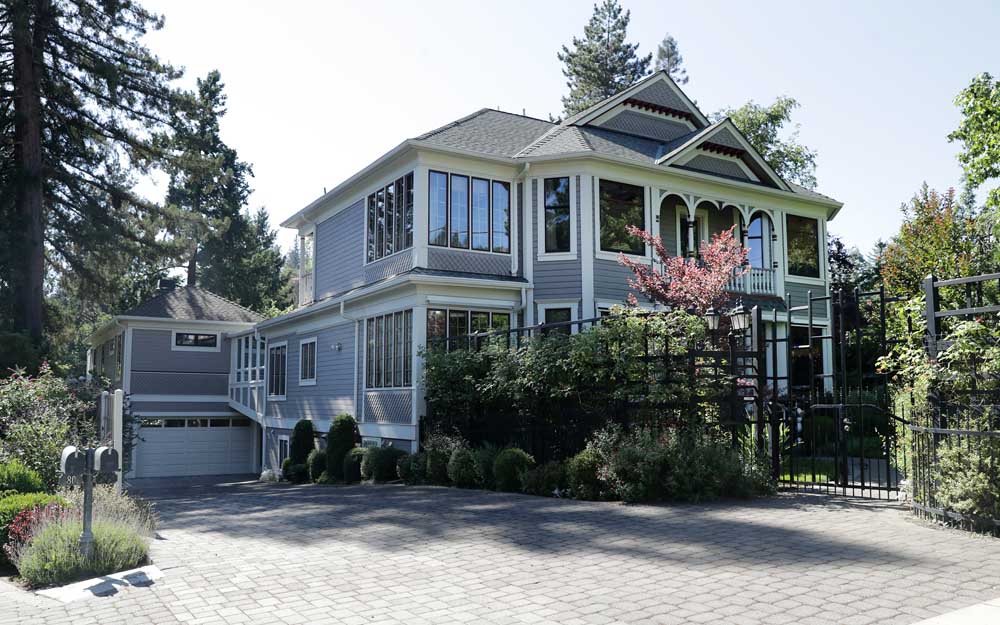5 historic houses on 1 Ashland block are for sale, and each one has a story
Published 8:00 am Wednesday, July 19, 2023

- Ashland 1902 Domingo Perozzi House, 88 Granite St.
Long before Ashland’s crown jewel, Lithia Park, was created in 1915, dairy farmer Domingo Perozzi let his cows roam on land he would later donate to the city park.
Trending
Perozzi and his family lived above the thriving downtown in an elegant Victorian on Granite Street, which also overlooks other famous landmarks: Ashland Creek, the retail-laced Plaza area and the Oregon Shakespeare Festival’s Angus Bowmer Theatre.
Granite Street was one of the first residential avenues in the city, and for various reasons, five historically significant homes in one block, including the 1902 Domingo Perozzi House, are for sale. They represent different eras and architectural styles, but all were constructed for the city’s most influential residents, and all have a fascinating story.
One of Ashland’s first settlers was Jacob Wagner, who walked the Oregon Trail from Idaho in 1850 to claim free land after the passage of the Oregon Donation Land Law. He lived decades in a home he built on Granite Street, close to one of his enterprises, a flour mill that supplied Gold Rush prospectors.
Trending
Mayor G.M. Grainger, who issued city funds for a jail and hand-pulled fire hose carts, lived in an eclectic-style house built in 1890 on Granite Street, named for the area’s profitable quarries. The handsome dwelling is “a highly visible part of Ashland’s architectural heritage,” says the property’s listing broker John Steinbergs.
At the turn of the last century, Ashland enjoyed economic prosperity. New residents were arriving on the same railroad tracks that farmers and manufacturers were using to ship their products to faraway buyers. Domingo Perozzi, a Swiss-born dairy farmer who founded the Ashland Creamery, was selling his milk and butter in Southern Oregon and Northern California.
At the turn of the last century, Ashland enjoyed economic prosperity. New residents were arriving on the same railroad tracks that farmers and manufacturers were using to ship their products to faraway buyers. Perozzi, a Swiss-born dairy farmer who founded the Ashland Creamery, was selling his milk and butter in Southern Oregon and Northern California. Here is the story of his house, along with four neighboring homes’ histories.
In 1902, newlyweds Domingo Perozzi and Louise Ganiere Perozzi moved into their new house at 88 Granite St. after their honeymoon, and their family lived there for nearly half a century. The Perozzis donated three acres to the city for Lithia Park and, with businessman Gwin S. Butler, the park’s Italian marble Butler-Perozzi Fountain across from the Butler Memorial Bandshell and near the Ashland Japanese Garden on Winburn Way.
The Domingo Perozzi House is for sale at $1,975,000. The three-level, Italianate-style residence has original features, and recent $550,000 in improvements seamlessly blend in modern luxury, says broker Dixie Hackstedde of John L. Scott Medford, who shares the listing with Ashland-based The Gibson Group.
Classic features include bay windows, stained glass, decorative moldings and bulls-eye corners on doors. Copper-etched doorknobs and solid hardwood floors were used throughout the house with 6,331 square feet of living space.
The paneled staircase in the entrance hall was constructed by Domingo Perozzi’s father-in-law, carpenter Charles Ganiere, according to historians whose researched helped the well-maintained residence be accepted on the National Register of Historic Places.
“The Perozzis were the envy of the Granite Street neighborhood for their new bathroom contained the first real bathtub in the neighborhood,” say national register historians.
Today, the 0.35-acre property gracefully accommodates many different lifestyles, say the listing brokers, from someone wanting to live on the main level with elevator access to other levels, to a multi-generational family benefiting from the three ensuite bedrooms, an extra bedroom, bathroom and powder room. The property would also appeal to anyone who wants a serene setting close to hiking trails and downtown restaurants, shops and theaters.
An elevated atrium with skylights and transparent walls connects the residence to the second-story entertainment space created over the newly expanded four-car garage. Views extend from the lush gardens and saline pool with waterfalls in the backyard to treetops and mountains.
A 1905 Craftsman house at 47 Granite St., listed at $1,075,000, has a connection to two generations of the Wagner family, whose contribution to the area inspired the naming of Wagner Creek in Talent and Wagner Butte in the Rogue-Siskiyou National Forest.
The root-cellar basement of the two-story house for sale is all that remains of a smaller home Jacob Wagner, a state senator from 1862 to 1868, built on the property in 1876. Wagner’s son, Fred Wagner, erected a new house three decades later. Fred was editor and co-owner of the Ashland Daily Tidings newspaper, which published from 1876 to 2021.
Jacob Wagner’s farmland was in Talent, five miles north of Ashland, but he also acquired rental properties in Ashland, where he planted magnolia trees, many of which survive. He died in his Ashland home at age 80 in 1900.
The Wagner Family House on 0.26 acres was modernized in the 1980s, but the sellers have restored or replaced historic features like hardwood floors and ornate cast-iron radiators, and added tasteful and practical improvements, says listing brokers Justin Donovan and Michaela Donovan of Ashland Homes Real Estate.
“Current owners have worked hard during this extensive remodel and have done an amazing job to keep the integrity of the time period, yet provide modern-day comforts with newer systems and amenities,” according to the real estate description.
Classic Craftsman elements include a large covered porch and an oak and leaded-glass front door that opens to the living room, sitting area and formal dining room with built-in china cabinets. Stairs lead to the primary bedroom suite with a copper soaking tub and custom tile shower. There are four more bedrooms, one more bathroom and a powder room in the house with 2,734 square feet of living space.
“This house is suited for many buyers, but mainly someone who appreciates its historic value but also wants modern amenities,” says Michaela Donovan. “And the yard is a big, blank canvas for whatever the next owner desires.”
An 1890 house with Italianate, Stick and Eastlake architectural features at 35 Granite St. is for sale at $1,395,000. Builder W.J. Schmidt created the drawings for what would later be called by the Ashland Tidings “one of the prettiest cottages in town” with “pleasant and light rooms … closets and other arrangements on the modern plan.”
Research by listing broker John Steinbergs with Tristan Freechild of Gateway Real Estate found the first homeowners were G.M. and Kate Vining Grainger. He was a labor contractor in the lumber industry who served two terms as Ashland’s mayor when the city grew enough to establish the 1893 City Hall at 20 E. Main St. to house city government and services.
The main Grainger residence, listed on the National Register of Historic Places, sits on 0.46 acres. The two-level house has a two-story bay with a turret and a covered front veranda that curves around one side. Inside, past the wood-paneled front door with diamond-shaped glass, are rooms with 10-foot-high ceilings. Elliptically shaped arches divide large rooms. There are three bedrooms and three bathrooms.
An attached one-bedroom studio brings the total living space to 4,081 square feet.
“The home is in great condition having maintained the original period details including fir flooring, wood paneling and 10-inch baseboards with molding,” says Steinbergs. “Newer updates include a spacious tile patio, two separate two-car garages and a modern foundation. The lot, zoned R-1-7.5 has the potential to split.”
An 1890 Craftsman on 0.33 acres at 55 Granite St. is for sale at $1,050,000. The historic house has original pocket doors, built-in cabinets and an enclosed sunporch within its 4,257 square feet of living space. The sale price also include a separate, furnished dwelling with a bedroom and bathroom.
The main house has a covered front porch, side deck and another covered deck for barbecuing. The interior is “spacious with plenty of period detail,” says listing broker Anna Houppermans of Gateway Real Estate.
Inside, there is a wood stove and window seat in the living room, as well as a library and multiple bonus rooms for crafting and media. The primary suite on the main level has a sitting room, large walk-in closet and bathroom. There are five more bedrooms and three more bathrooms.
Landscaping around the house includes fruit trees, a rose garden, drought-tolerant pollinator garden and a small pond.
“The perfect owner would have an appreciation for the style and period details of this home and would have a desire to do some updating,” says Houppermans. “It needs a little love but it’s an incredible opportunity to be in the heart of Ashland and have some income from the second unit.”
The original 1860 house, built in Gothic style for Jacob Wagner and his wife, Ellen, at 40 Granite St. was converted into the Wagner House/Butler Apartments in the 1920s and the eight-unit building on 0.32 acres is listed at $1,450,000.
The two-story structure has territorial mountain views, including Mount Ashland. There are three two-bedroom units and five one-bedroom units plus a laundry in the basement.
The apartment with simplified exterior adornments is “exceptionally located in a neighborhood of very fine homes,” says listing broker Genie Long with Salina Piddington of Gateway Real Estate. “Don’t miss this incredible opportunity to own an iconic property and a piece of Ashland’s history.”









